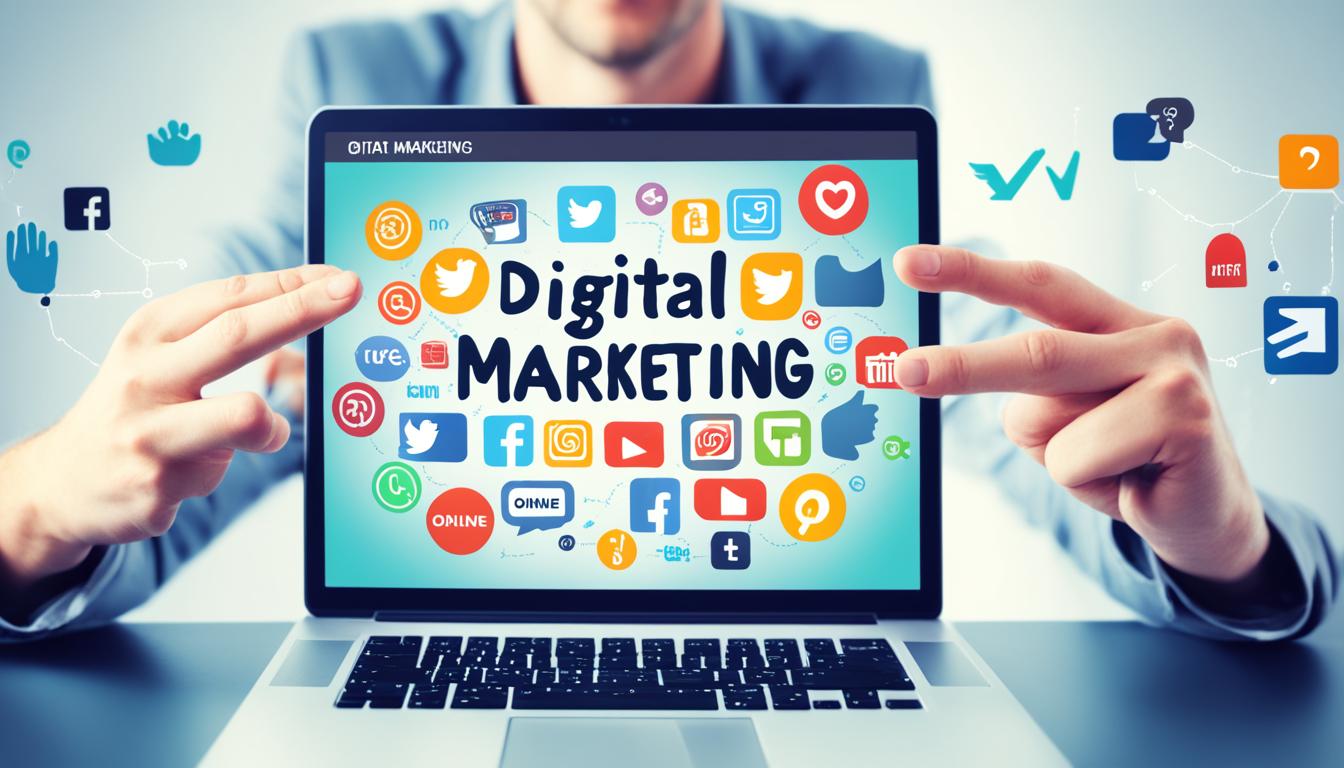Marketing communications, often referred to as MarCom, is a crucial element of any successful marketing strategy. It encompasses a wide range of activities and mediums used to communicate with the target market. From advertising and direct marketing to branding, online presence, PR activities, and sales presentations, marketing communications plays a pivotal role in building product demand and preference, as well as shortening the sales cycle.
Key Takeaways:
- Marketing communications is a fundamental part of a company’s marketing efforts.
- It includes various activities and mediums to reach and engage the target market.
- Marketing communications aims to build product demand and preference, as well as shorten the sales cycle.
- It encompasses advertising, direct marketing, branding, online presence, PR activities, and more.
- Successful marketing communications strategies incorporate a mix of different communication channels.
The Strategic Objectives of Marketing Communications
Marketing communication objectives play a crucial role in crafting a successful marketing strategy. They aim to achieve two key goals: building preference for the product or brand and shortening the sales cycle.
Building preference is all about positioning the product or company in the minds of the target customers. This involves creating a favorable image and perception that differentiates the offering from competitors. By effectively communicating the unique value proposition, benefits, and features, marketers strive to cultivate a sense of preference among consumers.
Shortening the sales cycle is equally important, as it involves streamlining the buying process and making it more efficient. Marketing communication plays a vital role in assisting sales and channel partners in identifying potential customers, engaging them effectively, and accelerating the purchasing journey. By utilizing various communication channels and messages tailored to different stages of the buyer’s journey, businesses can reduce the time it takes to convert leads into customers.
Achieving marketing communication objectives requires a careful balance between building preference and shortening the sales cycle. By creating a strong brand identity, offering compelling messages, and delivering targeted content through the right channels, businesses can establish a powerful connection with their target audience and drive demand.
The Importance of Balanced Marketing Communication Objectives
Achieving both objectives is essential to ensure long-term success. While creating preference can stimulate initial interest and attract customers, focusing solely on building preference without shortening the sales cycle may result in a lengthy buying process, leading to lost opportunities and lower conversions.
On the other hand, prioritizing shortening the sales cycle without building preference might lead to transactional relationships with customers, making it harder to retain loyalty and drive repeat business. By striking the right balance and aligning marketing communication objectives with overall business goals, companies can create a seamless customer journey that fosters preference and drives faster sales conversions.
| Objective | Key Components |
|---|---|
| Building Preference |
|
| Shortening the Sales Cycle |
|
The Marketing Mix and Integrated Marketing Communications
In the world of marketing communications, the marketing mix and integrated marketing communications (IMC) play a pivotal role in driving business success. Let’s explore how these two elements work together to create effective communication strategies.
The marketing mix, often referred to as the Seven Ps, is the foundation on which marketing communications is built. It encompasses seven key components: product, price, promotion, place, people, process, and packaging. Each element plays a crucial role in reaching and engaging target audiences, as well as in shaping the overall perception of the brand.
Integrated marketing communications takes the marketing mix a step further by combining all the communication tools and channels into a cohesive strategy. By integrating various elements such as advertising, public relations, direct marketing, and digital marketing, businesses can create a unified and impactful message across multiple platforms. This holistic approach ensures consistency and maximizes the impact of marketing communications efforts.
IMC allows marketers to align their communication promotions with the overall marketing strategy, targeting specific audiences at different stages of the customer journey. By understanding the target market, businesses can tailor their communication efforts to reach the right people, at the right time, and through the right channels. This targeted approach increases the effectiveness of marketing communications, ultimately driving business growth and success.
Types of Marketing Communications
Marketing communications encompass a variety of strategies and tactics to effectively engage with target audiences. Understanding the different types of marketing communications allows businesses to tailor their approaches and maximize their impact. Here are some key types of marketing communications:
- Digital marketing: Digital marketing leverages online channels such as social media platforms and email to reach and engage with customers. It offers the benefits of cost-effectiveness, measurability, and targeted advertising.
- Public relations: Public relations activities focus on managing and enhancing a brand’s reputation through media relations, stakeholder engagement, and strategic communications. It involves proactive outreach, crisis management, and maintaining positive relationships with various audiences.
- Advertising: Advertising involves promoting products or services through paid media channels, including television, radio, print publications, and online platforms. It aims to create awareness, generate interest, and drive sales.
- Social media: Social media platforms provide a cost-effective way to engage with a wide audience. Businesses can use social media to share content, interact with customers, build brand loyalty, and drive traffic to their websites.
- Direct marketing: Direct marketing involves reaching out to a targeted audience directly through personalized messages, such as emails, direct mail, and telemarketing. It allows businesses to build relationships, generate leads, and drive conversions.
- Sales promotion: Sales promotion tactics, such as discounts, coupons, contests, and special offers, stimulate immediate sales and encourage customer loyalty. They are often used in conjunction with other marketing communication channels to drive business revenue.
- Personal selling: Personal selling relies on one-on-one interactions between sales representatives and potential customers. It allows for direct communication, relationship building, and personalized product recommendations.
- Branding: Branding encompasses the overall identity and perception of a company or product. It includes elements such as brand logo, tagline, packaging, and brand messaging. Effective branding creates a distinct and memorable image in the minds of consumers.
- Print: Print marketing materials, such as brochures, flyers, posters, and newspaper ads, remain relevant in today’s digital age. Print can be particularly effective for local target audiences and industries where physical presence matters.
By incorporating these different types of marketing communications into their overall strategies, businesses can engage with their target audiences effectively, build brand awareness, and drive business growth.
Marketing Communications and Business Growth
Marketing communications plays a crucial role in business growth. By strategically using various communication tools and channels, businesses can effectively build brand awareness, create demand for products and services, maintain customer loyalty, and reach the right target audience. Marketing communications also contributes to shortening the sales cycle and highlighting a competitive edge in the market.
One of the key benefits of marketing communications is the ability to build brand awareness. Through targeted messaging and creative campaigns, businesses can increase their visibility and recognition among their target market. This increased awareness can lead to increased customer engagement and ultimately drive growth.
Customer loyalty is another important aspect of business growth, and marketing communications plays an integral role in maintaining it. By consistently communicating with customers and delivering personalized experiences, businesses can strengthen their relationships with customers and foster loyalty. This loyalty not only leads to repeat business but also generates positive word-of-mouth, attracting new customers and further contributing to business growth.
Creating demand for products and services is a key objective of marketing communications. Through compelling messaging, businesses can educate their target audience about the features and benefits of their offerings, generating interest and desire. Effective marketing communications can effectively spark demand and drive customers to take action, resulting in increased sales and business growth.
Marketing communications also plays a crucial role in shortening the sales cycle. By providing relevant information and highlighting the value proposition of their offerings, businesses can help potential customers make faster purchasing decisions. This streamlined sales cycle not only improves overall efficiency but also increases revenue and accelerates business growth.
Having a competitive edge is essential for business success, and marketing communications can help businesses differentiate themselves from competitors. Through targeted messaging and effective brand positioning, businesses can highlight their unique selling points and communicate their competitive advantages to the target audience. This differentiation can give businesses a distinct advantage in the market and contribute to their growth.
Achieving business growth requires reaching the right people, and marketing communications is instrumental in this aspect. By utilizing various channels and strategic targeting, businesses can ensure their messages are delivered to the intended audience. This targeted approach maximizes the effectiveness of marketing efforts, increases engagement, and drives business growth.
Overall, marketing communications plays a vital role in business growth by building brand awareness, maintaining customer loyalty, creating demand, shortening the sales cycle, highlighting a competitive edge, and reaching the right target audience. By integrating effective marketing communications into their strategies, businesses can achieve success and drive sustainable growth.
The Importance of Marketing Communications in the Digital Age
In today’s digital age, marketing communications has taken on an even greater importance. With the rise of digital marketing communications, businesses have access to a wide range of tools and channels that allow them to connect with a broader audience and engage customers on various platforms. These digital strategies, such as online presence, social media, and direct marketing, enable businesses to deliver personalized and targeted messages that drive customer engagement and conversions.
One of the key advantages of digital marketing communications is the ability to reach a wider audience. With an online presence, businesses can extend their reach beyond geographical boundaries and connect with customers around the world. Social media platforms, in particular, offer a cost-effective way to engage with customers, build brand awareness, and create a loyal following.
Direct marketing is another digital strategy that enables businesses to communicate directly with their target audience. Through email marketing, businesses can send personalized messages to their customers, promoting products or services based on their specific interests and preferences. This targeted approach enhances customer engagement and increases the likelihood of conversion.
Furthermore, digital marketing communications provide businesses with valuable insights and data about customer behavior and preferences. By analyzing data from online platforms, businesses can gain a deeper understanding of their target audience, allowing them to refine their marketing strategies and deliver more relevant and impactful messages.
For example, let’s consider a bakery that wants to increase online orders. Through digital marketing communications, the bakery can create an engaging website that showcases its products and allows customers to place orders online. Additionally, they can leverage social media platforms to share mouth-watering images of their pastries, engage with customers through comments and direct messages, and run targeted ads to reach potential customers in their local area.
Overall, the importance of marketing communications in the digital age cannot be overstated. It enables businesses to establish an online presence, engage with customers on social media, deliver personalized messages through direct marketing, and gain valuable insights into customer behavior. By leveraging these digital strategies, businesses can enhance their online visibility, connect with their target audience, and drive growth in the digital marketplace.
| Benefits of Digital Marketing Communications: |
|---|
| 1. Increased reach to a wider audience |
| 2. Cost-effective engagement on social media platforms |
| 3. Personalized messages through direct marketing |
| 4. Valuable insights and data for refining marketing strategies |
| 5. Enhanced online visibility and growth in the digital marketplace |
How Marketing Communications Supports Branding and Reputation Management
Marketing communications plays a vital role in branding and reputation management. It goes beyond simply promoting products or services and extends to shaping a company’s image and reputation in the eyes of its target audience. Through strategic messaging and engagement, marketing communications helps build a strong brand image, establish brand trust, and enhance brand credibility.
One key aspect of marketing communications that contributes to branding and reputation management is public relations. Public relations activities, such as press releases, media interviews, and communication campaigns, aim to shape a positive brand reputation by effectively communicating the company’s values, mission, and achievements. These efforts not only create awareness but also foster positive associations with the brand.
Marketing communications also plays a crucial role in managing brand image. By carefully crafting messaging and using appropriate communication channels, companies can project a consistent and cohesive brand identity. This helps create a distinctive brand image that resonates with consumers and differentiates the brand from its competitors.
Moreover, effective marketing communications fosters brand trust, which is essential for long-term success. By delivering consistent messages that align with the company’s values and promises, marketing communications builds trust and credibility with consumers. This trust translates into customer loyalty and advocacy, contributing to the overall success of the brand.
Overall, marketing communications plays a crucial role in supporting branding and reputation management. It helps build a strong brand image, establish brand trust, and enhance brand credibility. With effective marketing communications strategies, companies can shape a positive brand reputation and create enduring connections with their target audience.
Brand Image and Reputation Management: A Comparative Analysis
| Aspect | Brand X | Brand Y |
|---|---|---|
| Brand Image | Modern and edgy | Classic and elegant |
| Brand Trust | Established and reliable | Dependable and trustworthy |
| Brand Credibility | Industry leader with proven track record | Reputable and respected |
By analyzing the brand image, trust, and credibility of Brand X and Brand Y, we can see how marketing communications strategies have a significant impact on shaping and managing these aspects of a brand. Brand X positions itself as a modern and edgy brand, attracting a specific target audience. On the other hand, Brand Y has a classic and elegant brand image, appealing to a more traditional customer base.
Both brands have successfully built trust and credibility with their respective audiences. Brand X is seen as an established and reliable brand, while Brand Y is perceived as dependable and trustworthy. These perceptions are the result of consistent messaging and well-executed marketing communications campaigns.
In summary, effective marketing communications plays a crucial role in supporting branding and reputation management. It helps shape a brand’s image, build trust, and enhance credibility. By leveraging strategic messaging and engagement, companies can establish a strong and reputable brand that resonates with their target audience.
The Role of Marketing Communications in Sales and Promotion
Marketing communications plays a vital role in driving sales and promoting business growth. By utilizing effective marketing strategies, businesses can attract customers, encourage purchases, and stimulate revenue generation. In this section, we will explore three key aspects of marketing communications that contribute to sales success: sales promotion, direct marketing, and personal selling.
Sales Promotion
Sales promotion activities are essential in creating excitement and incentivizing customers to make a purchase. They can include special offers, discounts, contests, loyalty programs, and more. By strategically implementing sales promotions through various communication channels, businesses can attract new customers, foster brand loyalty, and increase sales volume.
Direct Marketing
Direct marketing involves directly reaching out to potential customers through personalized and targeted communication. This can be done through channels such as email marketing, direct mail, telemarketing, or mobile marketing. By tailoring messages to specific audiences and utilizing customer data, businesses can effectively engage with customers, generate leads, and drive sales.
Personal Selling
Personal selling is a face-to-face interaction between a sales representative and a potential customer. This form of marketing communication allows businesses to build relationships, address customer concerns, and provide personalized product information. Through effective personal selling techniques, businesses can influence purchasing decisions, showcase the value of their products, and ultimately close sales.
By leveraging the power of marketing communications strategies, businesses can effectively promote their products, attract customers, and achieve sales success. The table below provides a comprehensive overview of the roles and benefits of marketing communications in sales and promotion:
| Marketing Communication Strategy | Role in Sales and Promotion | Benefits |
|---|---|---|
| Sales Promotion | Creating excitement and incentivizing customers | Increased customer attraction, brand loyalty, and sales volume |
| Direct Marketing | Targeted communication and lead generation | Engagement with specific audiences, lead generation, and increased sales |
| Personal Selling | Building relationships and influencing purchasing decisions | Customer relationship development, showcasing product value, and closing sales |
By effectively incorporating marketing communications into their sales strategies, businesses can drive growth, increase revenue, and gain a competitive edge in the market. The seamless integration of sales promotion, direct marketing, and personal selling efforts ensures a comprehensive approach to attracting and retaining customers, stimulating purchases, and ultimately achieving business success.
Conclusion
Marketing communications is a fundamental part of any company’s marketing strategy. It encompasses a wide range of communication tools and channels that are used to reach target markets, build brand awareness, drive sales, and create meaningful customer engagement.
By understanding the strategic objectives of marketing communications, businesses can effectively position their products or services in the minds of their target customers and shorten the sales cycle. Integrated marketing communications (IMC) allows for a cohesive approach, where all communication efforts work together to deliver a consistent message.
The various types of marketing communications, such as digital marketing, public relations, advertising, social media, and direct marketing, provide businesses with the flexibility to choose the most appropriate channels to reach their target audience. Leveraging the power of marketing communications can help businesses achieve brand awareness, loyalty, and growth in the digital age.
Overall, marketing communications plays a crucial role in supporting brand building, reputation management, sales promotion, and business growth. By developing effective marketing communication strategies, businesses can successfully connect with their target audience, drive sales, and achieve their marketing goals.





